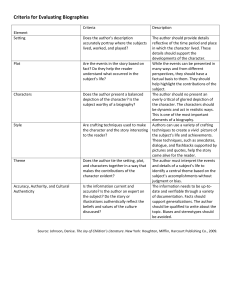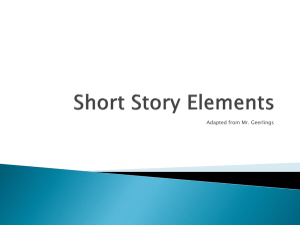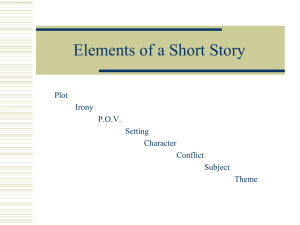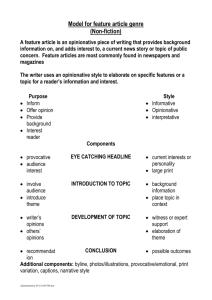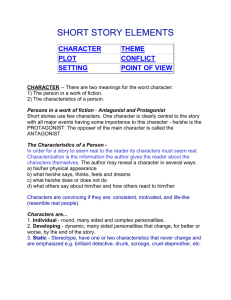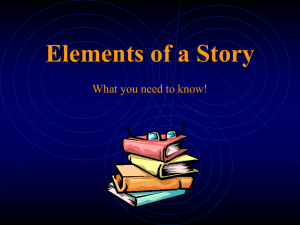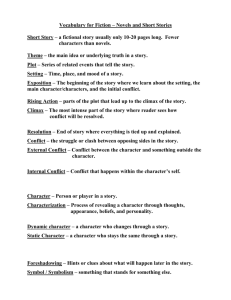Prose Fiction Terminology
advertisement
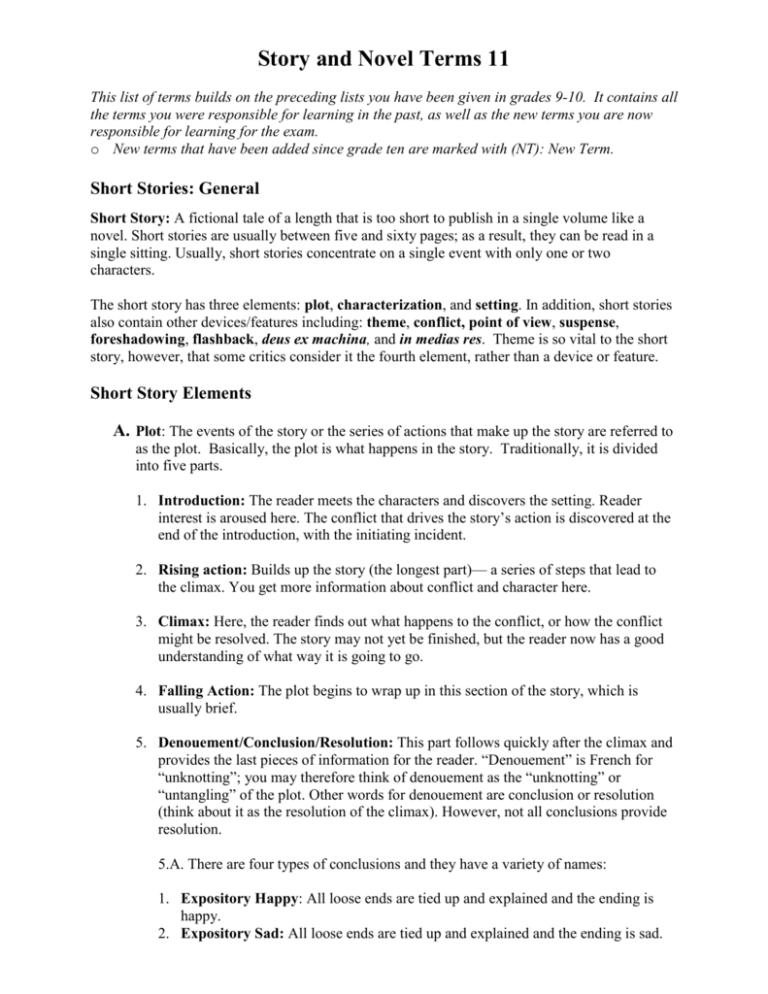
Story and Novel Terms 11 This list of terms builds on the preceding lists you have been given in grades 9-10. It contains all the terms you were responsible for learning in the past, as well as the new terms you are now responsible for learning for the exam. o New terms that have been added since grade ten are marked with (NT): New Term. Short Stories: General Short Story: A fictional tale of a length that is too short to publish in a single volume like a novel. Short stories are usually between five and sixty pages; as a result, they can be read in a single sitting. Usually, short stories concentrate on a single event with only one or two characters. The short story has three elements: plot, characterization, and setting. In addition, short stories also contain other devices/features including: theme, conflict, point of view, suspense, foreshadowing, flashback, deus ex machina, and in medias res. Theme is so vital to the short story, however, that some critics consider it the fourth element, rather than a device or feature. Short Story Elements A. Plot: The events of the story or the series of actions that make up the story are referred to as the plot. Basically, the plot is what happens in the story. Traditionally, it is divided into five parts. 1. Introduction: The reader meets the characters and discovers the setting. Reader interest is aroused here. The conflict that drives the story’s action is discovered at the end of the introduction, with the initiating incident. 2. Rising action: Builds up the story (the longest part)— a series of steps that lead to the climax. You get more information about conflict and character here. 3. Climax: Here, the reader finds out what happens to the conflict, or how the conflict might be resolved. The story may not yet be finished, but the reader now has a good understanding of what way it is going to go. 4. Falling Action: The plot begins to wrap up in this section of the story, which is usually brief. 5. Denouement/Conclusion/Resolution: This part follows quickly after the climax and provides the last pieces of information for the reader. “Denouement” is French for “unknotting”; you may therefore think of denouement as the “unknotting” or “untangling” of the plot. Other words for denouement are conclusion or resolution (think about it as the resolution of the climax). However, not all conclusions provide resolution. 5.A. There are four types of conclusions and they have a variety of names: 1. Expository Happy: All loose ends are tied up and explained and the ending is happy. 2. Expository Sad: All loose ends are tied up and explained and the ending is sad. 3. Surprise or Twist: Something happens that the reader does not expect at all. 4. Unresolved/Indeterminate/Cliffhanger: The reader is left with questions and has to, in part, supply the ending him or herself. Some loose ends are left to dangle. 5.B. Anti-Climax: A dull or disappointing ending to something after increasing excitement. For example: After the weeks of preparation, the concert itself was a bit of an anticlimax. In connection to a story or novel, it means an ending that doesn’t measure up to the plot events that precede it (the ending is anti-climactic). Plot Diagram: Also known as Freytag’s Pyramid, the story diagram or plot diagram, was invented in 1864 by Gustav Freytag to visually represent the five plot parts and their relationship with one another. Modern stories may or may not tidily fit Freytag’s Pyramid. Climax Rising action Fallin action Conclusion/Denouement Introduction Initiating inciden B. Characterization: The collection of characters, or people, in a short story is called its characterization. A character, of course, is usually a person in a story, but it can also be an animal (think about Flounder the fish in Disney’s Ariel or Simba in Disney’s The Lion King or the dogs in 8 Below). Character Types Protagonist: The main character in the story. The protagonist is usually, but not always, a “good guy.” Antagonist: The force against the protagonist. The antagonist is usually another character, but not always, especially if the conflict is “person against self.” The antagonist is usually described as “the bad guy”, although that description doesn’t work if the conflict is person against self or person against environment. Flat: This is a minor character with one or maybe two sides to the personality. These characters might not seem very realistic or life-like because so little is known about them. Round: These characters are believable and complex people with several sides to their personality. They are lifelike and behave like real people would, if real people were in those same situations. Dynamic: Also known as a kinetic character, a dynamic character changes in some important way because of plot events. For example: a cruel old man might see the error of his ways and become generous and kind, or a gentle girl becomes vicious and angry because her parents divorce. Static: These characters are the opposite of dynamic characters. These people don’t change through the course of a story. They have the same personality throughout. Stereotypical: Also known as stock, these characters are people who are easily recognized as “types”. It wouldn’t matter in which story they appear, they are always the same. For example, the old witch-like woman, the geeky scientist, the airhead, and the dumb jock characters are all stereotypical, or stock, characters. In this sense, they are also clichés.* (A cliché is an over-used expression, like “light as a feather,” or an over-used idea, like the stereotypical characters just discussed.) Character Foil: A character foil, or simply “foil”, occurs when two characters balance each other in some way; they are almost like two halves of a whole person. This is when a character is portrayed as opposite of another character in a particular way. By putting the two characters next to each other, the different characteristic is emphasized. This helps readers recognize particular characteristics. A good person might be a foil for an evil person, for example. Caricature: A character in a piece of literature who has very exaggerated characteristics, usually for comic effect. In a way, a caricature is an extreme form of stereotype (NT). Character Analysis: The author may choose any of six ways to reveal a character to the reader. The reader must therefore be prepared to watch for "clues" about each character in these same six ways: 1. physical appearance 2. things the character says 3. things the character does (actions) 4. things the character thinks 5. things other characters say about the character 6. author information Character Sketch: A character sketch is a description of a character's moral and personality qualities, written in paragraph form with specific examples from the story in question. Usually, the character terms (see above) are used in the course of the description. Physical appearance and dress (if showing something about personality) are sometimes described as well. C. Setting: The author may choose to state the setting clearly or leave it to the reader to infer from textual clues (such as weather). There are two parts to a complete setting: emotional and physical. The mood* (or atmosphere*) of a story is the emotional setting, so readers need to concentrate on words that evoke feeling and emotion. The time, place, and season comprise the physical setting, so readers need to concentrate on words that describe physical details. Short Story Devices and Features A. Theme*: The message of the story, stated in one or two complete sentences. When a person describes a story’s theme, the person is describing what can be learned about life and/or people from the story. Theme is so important, it is often described as the fourth element of the short story. Sometimes theme is confused with “the moral” of the story. Also, do not confuse theme with ‘the topic’ which is the subject a piece of writing is about. For example, the topic of Scooby Doo is solving mysteries, yet one theme of Scooby Doo is that good triumphs over evil. Abandonment Alienation Ambition American Dream Birth/Childhood Coming of Age Commoditization Commercialism Commerce Community Cruelty Death Education Ethics Experience Fall from Grace Family Fate Freedom Futility Gender Grief Growth and initiation Guilt Heroism Hope Human relations Identity Illness Individual & Nature Individual & Society Individual & God Innocence Isolation Journey & Struggle Justice Love & Friendship Memory Nationalism Nature Oppression Parenthood Pride Race Regret Rejection Religion Responsibility Revenge Sacrifice Science & Technology Sex & Sensuality Social Class Spirituality Stages of Life Success Suffering Survival Time Tradition Violence Work It has been argued that there are anywhere between 3 and 40 main themes in literature that continue to be explored by each successive generation of writers. No one knows for what the real number is--it depends on who you ask--but below is a list, not necessarily inclusive, of the most common ones. There are many variations, and there are often overlaps as well. So, right or wrong, in no particular order, here they are. 1. 2. 3. 4. 5. 6. 7. 8. 9. Man Struggles Against Nature: Man is always at battle with human nature, whether the drives described are sexual, material or against the aging process itself. Man Struggles Against Societal Pressure: Mankind is always struggling to determine if societal pressure is best for living. Check out books like Revolutionary Road or Mrs. Dalloway for examples of characters who know how society says they should live, but feel society’s dictation is contrary to what makes them happy. Man Struggles to Understand Divinity: Mankind tries to understand and make peace with God, but satisfaction is elusive and difficult. Crime Does Not Pay: A popular theme played out in books throughout time is the concept that honesty is honored and criminals will eventually be caught. Crime and Punishment and "The Telltale Heart” are two stories written on this theme. Overcoming Adversity: Many books laud characters who accept a tough situation and turn it into triumph. Scarlett O’Hara in Gone With the Wind exemplifies a shrewd person who finds a way to come out on top despite failed relationships and an economic depression after the Civil War. Friendship is Dependent on Sacrifice: This is the idea that you can’t have friends if you don’t act like a friend. The Importance of Family: Sacrifices for family are honored and explored, as are the family bonds that survive adversity. Yin and Yang: Just when you think life is finally going to be easy, something bad happens to balance it all out. Love is the Worthiest of Pursuits: Many writers assert the idea that love conquers all, appealing to the romantic side of us. 10. Death is Part of the Life Cycle: Literary works with this theme show how death and life and intricately connected. 11. Sacrifices Bring Reward: Sacrifices and hard work pay off in the end, despite the challenges along the way. 12. Human Beings All Have the Same Needs: From Montagues to Capulets in Romeo and Juliet or the characters in S.E. Hinton’s The Outsiders, book after book asserts that rich or poor, educated or dumb, all human beings need love and other basic needs met. 13. The Great Journey: This follows a character or characters through a series of episodic adventures as they travel. It may be a sad story or a happy story, or it may even be comedic. Huckleberry Finn, Heart of Darkness, The Hitchhiker’s Guide to the Galaxy, and The Odyssey are good examples. In film, this theme can be seen in Apocalypse Now and National Lampoon's Vacation. 14. Loss of Innocence: Sometimes called the "coming of age story," this most commonly introduces an “innocent” character to the evil or complexity of the real/adult world. In literature, we might look at David Copperfied or most of the Nick Adams stories by Ernest Hemingway, like "Indian Camp" and "The End of Something." In film, we might look at Stand by Me. 15. The Noble Sacrifice: The sacrifice can be for any reason except self--a loved one, an enemy, a group of people, the whole of humanity, a dog--but the bottom line is that the protagonist sacrifices himself or herself in an effort to save others. In literature, this is demonstrated in the story of Jesus in the New Testament and King Arthur in Mallory's Morte d’Artur. This theme is used is used in the films Glory, Armageddon, The Green Mile, and in just about any war movie where the hero dies gloriously. 16. The Great Battle: The Iliad and A Tale of Two Cities are classic examples of this theme. It is about people or groups of people in conflict. It is sometimes a good vs. evil story like 1984 by George Orwell, but not always. The film The War of the Roses, starring Kathleen Turner and Michael Douglas, is an example of a battle in which neither character is wholly good or evil. In theatre, we see this theme at work in Westside Story and Les Miserables. We often see this theme in horror or science fiction, like in Alien and Terminator, where the antagonist (a monster, creature, human, alien, computer, etc.) is trying to kill the protagonist, who must fight to stay alive and/or defeat the antagonist. Sub-categories would be person vs. person, person vs. nature, person vs. society, person vs. technology and etc. 17. The Fall From Grace: This theme shows us people going where only God should go, doing what only God is meant to do, or attempting to do something that human beings should never do. This is always followed by misfortune, whether it is the direct result of their action or an act of God. We see this in the tales of Coyote’s theft of fire in the Native American tradition, or in the story of the Tower of Babel and the Garden of Eden in The Old Testament. Other examples would be the Prometheus myth, Pandora’s Box, and the story of Icarus. Frankenstein by Mary Shelly is another work exploring this theme, and we have seen it at work in the films Jurassic Park and Westworld. 18. Love and Friendship: Romeo and Juliet is a classic love story, as is the story of Lancelot and Guenivere. The films You’ve Got Mail and Message in a Bottle are also love stories. The ending may be be happy, sad, or bittersweet, but the main them is romantic love. Also included in this theme is platonic love--friendship--like in the movies Wrestling Ernest Hemingway and Midnight Cowboy. All Romance novels, whether straight or gay, fit into this category. All “buddy films” like Butch Cassidy and the Sundance Kid and Thelma and Louise fit into this category. 19. The Capriciousness of Fate: Greek tragedies fit this category. Often, there is a major reversal of fortune. It could be from good-to-bad or from bad-to-good. Oedipus Rex is a classic work that explores the concept of fate and destiny, having an unhappy ending. 20. 21. 22. 23. Cinderella is also a reversal of fortune story, but has a happy ending. In film, we have seen this theme at work in Pretty Woman. The common element is that there is some force guiding the person’s life over which he or she has no control. Revenge: The subject is obvious, but the outcome differs. Sometimes the outcome is good, like in the movies Revenge of the Nerds or Animal House. Sometimes the outcome is bad, as in Macbeth and Moby Dick. Other movies based on this them are Revenge, staring Anthony Quinn and Kevin Costner, and Payback, starring Mel Gibson. The Big Trick; In this one, someone or some group of people intentionally trick someone else. Rumplestiltskin and Little Red Riding Hood are in this category. Stone Soup is an old story in which several men trick the inhabitants of a village into providing them with food. This theme was evident in Snatch, starring Brad Pitt, and The Sting, staring Robert Redford and Paul Newman. The Big Mystery: Something unexplained happened and it is the protagonist’s job to find an explanation for it. The story of Sherlock Holmes are good examples, as are the Hardy Boys and Nancy Drew mysteries. In film, we have seen it Silence of the Lambs and The Maltese Falcon, and it took a comedic turn in Clue and The Pink Panther. Almost all police and detective dramas work within this form, as do most espionage and spy thrillers. Agatha Christy and Tom Clancy work within this form. Even More Themes: People are out of place in Nature and need technology to survive • People are destroying nature and themselves with uncontrolled technology • Society and a person's inner nature are always at war • Social influences determine a person's final destiny • A person's identity is determined by place in society • You can't change who you are • A child must go through a series of obstacles before becoming a grownup • Everyone had an inner child. Sometimes it holds us back, sometimes it brings us happiness • A person grows by facing obstacles • Enjoy life now because we all die too soon • By the time we understand life, there is too little left to live • Death is part of living, giving life its final meaning • Sometimes people do stupid things to impress other people • Honesty is/isn’t always the best policy • Family is the most important thing • Faith is the most important thing • A good friend is hard to find • Don't judge a book by its cover • Things aren't always what they seem • We can change the future. (Free will) • The future is already set for us. (Fate) • Every action has a reaction • The fittest are most able to survive • With freedom comes responsibility • It is important to be your own person • Love is stronger than hate • Good is stronger than evil. B. Conflict: Conflict drives the plot forward. The reader discovers the conflict by the end of the introduction with the initiating incident, which is an event that demonstrates the conflict to the reader and begins the rising action. Either internal or external conflict can be the main conflict of a story and therefore the primary driver of the plot: Internal Conflict: When the conflict is inside a character in a short story/ novel as an internal struggle. Usually characters, like real people, have conflicting fears and goals that cause them to behave in certain ways. These secret conflicts (secret from the other characters in the text) represent the character’s internal conflict. The reader, of course, is aware of the internal conflict because he/she can see the character’s thoughts. External Conflict: When the conflict is outside a character in a short story/ novel. External conflict is the opposite of internal conflict, in that the conflict is obvious to all the other characters in the story, as well as the reader. External conflict is best described as the adversities faced by the character during the plot. Additionally, there are four different categories of conflict: Person versus person Person versus self Person versus environment Person versus the supernatural/machine C. Point of View: The writer selects the point of view from which to tell the story that best suits his/her intentions as a writer First Person: “I” is the central character and tells his or her own story. Second Person: The story is told about “you”; for example, “You could see the anger in her eyes.” Third Person—where the point of view can be one of: o Omniscient: Characters are referred to as “he” and “she”, and the reader knows what is going on in their heads. All characters’ thoughts are made clear in the text. o Limited Omniscient: Characters are referred to as “he” and “she”, and the reader knows what is going on in some of their heads. The remaining characters are treated in the objective fashion. o Objective: The story is about “he” or “she”, and the author records action objectively, as a movie camera would. The reader does not see any of the character’s thoughts (doesn’t get inside their heads). D. Deus ex Machina: From the Latin "god out of the machine." This device refers to any artificial device that is not a natural extension of the plot that allows for an easy–and unbelievable—resolution of conflict. Deus ex machina is an improbable plot event. E. In Medias Res: Beginning in the middle of the action. A sample beginning to such a story: “I saw the punch coming but couldn't duck in time. I collapsed to the floor, nose gushing red, clotted blood.” F. Flashback: When a character thinks back to an event that occurred before the story began. Sometimes flashbacks are written as separate “interrupter” sections within a novel. Flashbacks are also used in short stories. G. Foreshadowing: A hint of events to come. Also used extensively in both novels and short stories. H. Suspense: Anxiety or apprehension resulting from an uncertain, undecided, or mysterious situation. Suspense is when the writer creates excited anticipation of an approaching climax in the reader. Novels Many of the terms associated with short stories are also used in novels, particularly setting, characterization, plot, and theme. The difference between a novel and a short story is in the length and complexity of the narrative. Novels are longer and more complex than short stories; therefore, they take several sittings to read in their entirety. Novels, like short stories, can be written in different style categories or sub-genres. The different sub-genres include mystery, science fiction, fantasy, romance, history, and contemporary, to name a few. Style: Writers use many, many different techniques to attract reader interest and attention or to accomplish their literary purpose in short stories, novels, poems and plays. Several such stylistic techniques* follow here: Antithesis: The use of contrast, or opposition, for effect. In creative writing, antithesis is a rhetorical device where a sentence or two contains a balanced contrast of ideas, so either the two halves of a single sentence, or the two sentences placed side-by-side, show complete contrast for powerful effect. For example, “Give me liberty ,or give me death!” Chronological Order: Writers often choose to describe plot events in chronological order, meaning the events happen one after another and are not told in a mixed-up way. With a chronological approach, first things first, second things second, and so on… Dialect: The style of speaking used by a particular character. A dialect is influenced by where a person is from, the way he or she pronounces words, and the history of the language in the area. To many people, a dialect is like having an accent. For example, there are many different English dialects in the United Kingdom: Scottish, Irish, Welsh, and English all speak in different ways. Writers will use different dialects when creating different characters. (NT) Diction: An author’s choice and arrangement of words in a literary work. Diction varies according to the ends a writer wishes to achieve as well as to the nature of the literary form, the subject, and the style of the day. The ornate style of much eighteenth-century prose, therefore, was considered elegant in its time but would be deemed wordy in a contemporary essay. Direct Presentation: Writers who provide information directly to their readers are using direct presentation. Readers can locate specific information about a character, for example, by finding it right in the text. Epiphany: The sudden realization, by a character, of something very critical. An epiphany is a life-changing moment, where new knowledge is suddenly gained. (NT) Indirect Presentation: Writers often choose indirect presentation in order to inform their readers about their characters or other story elements. Indirect presentation of information requires readers to use their inference skills, as the specific information is shown rather than told to the reader. Irony: There are three different kinds of irony. o Verbal irony occurs when the opposite of what is said is actually meant (sarcasm is an extreme form of verbal irony). o Situational irony occurs when an event occurs that is the opposite of what was expected by the character and/or reader. o Dramatic irony is when a character says something, but the audience/reader knows more than the character does about other characters or events, so the statement comes across with a double meaning that the audience/reader “gets” and the character doesn’t. Narration: Something that is narrated—an account, a story, a novel–is a narration. Actually telling the story via the process of narrating is also narration, so “narration” is a verb as well as a noun. Narrator: The teller of the story or the person speaking in the story. Paradox: A statement, person, or situation that seems to be contradictory or opposed to common sense; it is an unusual pairing of non-matching (incongruous) ideas. Authors use paradox to provoke insight, so while a paradoxical statement appears to contradict itself, it often, on closer examination, reveals a truth. In Shakespeare’s Romeo and Juliet, for example, Juliet paradoxically refers to Rome as her “only love, sprung from [her] only hate.” “The child is the father of the man” (William Wordsworth) is also a paradoxical statement. Satire: A style of writing that has the goal of mocking or scorning an individual, an institution, or society as a whole. Angry and bitter satire is called Juvenalian satire while gentle mockery is called Horatian satire. Sarcasm: When a character (or person) uses verbal irony to express bitter or angry feelings about something. The reverse of what is meant is said. For example, a person might say, “That’s an act of genius!” when he really means it is the act of a fool. Symbol: A symbol has two levels of meaning: a literal level and a figurative level. Objects, characters, events and settings can all be symbolic in that they represent something else beyond themselves. E.g. the dove is literally a bird, but it has become a universal symbol of peace. The collection of symbols in a novel or short story is called symbolism. Other Forms of Fiction Allegory: A story that has a deeper or more general meaning in addition to its surface meaning. Allegories are composed of several symbols or metaphors. For example, in William Golding’s Lord of the Flies, the boys on the island end up ruining the island. The story of this destruction is a symbol of how people are inherently evil – they will destroy their environment just as Adam and Eve destroyed their chances of living in Paradise (the island is a tropical Paradise). Similarly, when the conch is broken, it symbolizes the destruction of democracy and the increasing emergence of evil on the island. (NT) Legend: A story, sometimes of a national or folk hero, which has a basis in fact, but which also includes imaginative material. The story of Paul Bunyan is regarded as legend, for it is believed that there was an extraordinary lumberjack who served as the model. The King Arthur stories are another example of legend because it is believed there was a real king who, along with his knights, was the source of the stories, even though the stories themselves are clearly fictional. (NT) Myth: An anonymous tale of unknown origins, a myth was usually created to explain a natural phenomenon, such as lightning or the cycles of the moon. Myths also explained the origin of the world or the people and animals on it, as well as the feats of gods and goddesses. (NT) Fable: A brief narrative, in either prose or verse, which illustrates some moral truth. The characters are often animals but not always. Think about Aesop’s Fables, such as the one about the fox and the grapes or the tortoise and the hare. The moral truth illustrated by the fable is sometimes something in its own right: a proverb. (NT) Proverb: A short popular saying, similar to an epigram (see poetry handout), which is generally an observation or a piece of advice. Proverbs may be attributed to an individual, but most are anonymous products of folklore; for example, “A fool and his money are soon parted.” (NT) Folk Tale: A traditional story handed down in either oral or written form. This term covers a variety of forms of material, from primitive myths to fairy tales. (NT)
